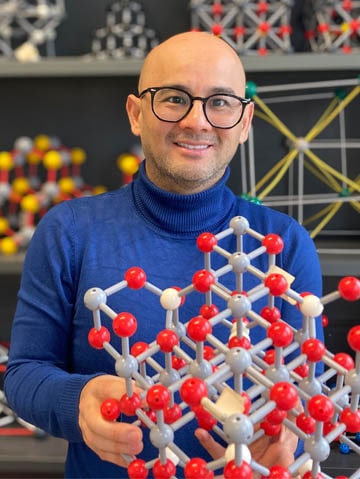← Retour vers le trombinoscope
 Chaire de Professeur Junior
Chaire de Professeur JuniorMail :
Tel : 03 22 82 75 70
Titulaire de la chaire de professeur à l’Université de Picardie Jules Verne (UPJV), au sein du Laboratoire de Glycochimie et des Agroressources d'Amiens (LG2A) mes travaux de recherche ont pour objectifs de conceptualiser, synthétiser et caractériser des matériaux fonctionnels basés sur les bioressources, de déterminer et de comprendre la relation structure-propriétés. L’enjeu est de développer des matériaux avancés dans le respect de l'environnement et à faible empreinte écologique pour le domaine de l’énergie, de la santé et de l’environnement. Ces matériaux sont utilisés pour la production d’hydrogène, la capture et la conversion du dioxyde de carbone, le stockage l’énergie ou encore le développement de dispositifs biomédicaux.
Organique, inorganique, état solide, chimie supramoléculaire, chimie réticulaire, chimie des matériaux, matériaux poreux, relation structure-propriétés; synthèse des metal-organic frameworks et covalent organic frameworks; production d’hydrogène, capture et conversion du dioxyde de carbone, batteries; stockage d’énergie, énergie propre et renouvelable, séparation et adsorption de gaz, catalyse, design molécules et matériaux pour la santé et l’environnement.
Concevoir, synthétiser et caractériser des matériaux fonctionnels pour le développement de l’énergie, la santé et l’environnement.
Isostructural coordination polymers of the tethering naphthalene anchored bis(2-methylpyridinecarboxamide) ligand: single crystal, XPS, EDS and theoretical studies |
Synthesis and preparation of poly (AM-co-AMPS)/GO nanocomposites hydrogel as a rheology modifier and fluid loss controller for use in oil well cementing |
Synthesis, characterization, and rheological behavior of HPG graft poly (AM-co-AMPS)/GO nanocomposite hydrogel system for enhanced oil recovery |
Two different pore architectures of cyamelurate-based metal–organic frameworks for highly selective CO2 capture under ambient conditions |
Missing puzzle in crystal engineering: 2-pyridone and [1,3,5]-triazine-2,4-diamine, the two most common cyclic hydrogen bonding sticky sites, in a single core |
An insight into sensitive detection of metal ions using a novel cobalt MOF: single crystal, photoluminescence, and theoretical studies |
Recent progress on the design and development of diaminotriazine based molecular catalysts for light-driven hydrogen production |
Comparative studies of synthesis, structure, optical properties and conductivity of the monoclinic phases Na2Co6Mn2(PO4)6 and Na2Co6Ni2(PO4)6 |
Synthesis of Na3Co7(PO4)6 by sol-gel and solid-state methods |
SrFe12O19 Powder and Polyvinyl Alcohol-Coated SrFe12O19 Films Synthesized Using Tartaric Acid and Study of their Structural, Magnetic, Morphological and Electrical Properties |
cis-[6-(Pyridin-2-yl)-1,3,5-triazine-2,4-diamine](dichloride) Palladium(II)-Based Electrolyte Membrane Reactors for Partial Oxidation Methane to Methanol |
Defective Metal-Organic Framework-808@Polyaniline Composite Materials for High Capacitance Retention Supercapacitor Electrodes |
S-Heptazine N-ligand based luminescent coordination materials: synthesis, structural and luminescent studies of lanthanide-cyamelurate networks |
Novel dielectric response in B-site zirconium-doped CaCu3Ti4O12 ceramics: A structural, optical and electrical study |
Design, structural characterization and Hirshfeld surface analysis of Ni(II) and Zn(II) coordination polymers using mixed linker synthetic strategy based on tetratopic and macrocyclic N-donor ligands |
Photocatalytic Carbon Dioxide Reduction and Density Functional Theory Investigation of 2,6-(Pyridin-2-yl)-1,3,5-triazine-2,4-diamine and Its Cobalt and Nickel Complexes |
New approach by electrospray technique to prepare a gas diffusion layer for the proton exchange membrane fuel cell anode |
Rheological and thermal stability of interpenetrating polymer network hydrogel based on polyacrylamide/hydroxypropyl guar reinforced with graphene oxide for application in oil recovery |
Hydrogen Bond Patterns of Dipyridone and Bis(Hydroxypyridinium) Cations |
Synthesis, characterization and Hirshfeld surface analysis of a mixed-ligand copper (II) coordination polymer from 1,4,8,11-tetraazacyclotetradecane and pyromellitic dianhydride |
Study of early P91 dual corrosion in steam and simulated combustion gases from a gas-fired boiler |
Flexible and porous 2D layered structures based on mixed-linker metal-organic frameworks for gas sorption studies |
Synthesis, crystal structure, characterization of pyrazine diaminotriazine based complexes and their systematic comparative study with pyridyl diaminotriazine based complexes for light-driven hydrogen production |
Design of a [FeFe] macrocyclic metallotecton for light-driven hydrogen evolution reaction |
Amidine/Amidinate Cobalt Complexes: One-Pot Synthesis, Mechanism, and Photocatalytic Application for Hydrogen Production |
Graphene oxide-induced interfacial transcrystallization of single-fiber milkweed/polycaprolactone/polyvinylchloride composites |
Intercalated 2d+2d hydrogen-bonded sheets in co-crystals of cobalt salt with 1H,1'H-[3,3']bipyridinyl-6,6'-dione |
A Rational Design of Microporous Nitrogen-Rich Lanthanide Metal–Organic Frameworks for CO2/CH4 Separation |
Water-dispersible polyaniline/graphene oxide counter electrodes for dye-sensitized solar cells: Influence of synthesis route on the device performance |
Conversion of Methane into Methanol Using the [6,6?-(2,2?-Bipyridine-6,6?-Diyl)bis(1,3,5-Triazine-2,4-Diamine)](Nitrato-O)Copper(II) Complex in a Solid Electrolyte Reactor Fuel Cell Type |
Building coordination polymers using dipyridone ligands |
Controlling Molecular Organization by Using Phenyl Embraces of Multiple Trityl Groups |
Mimicking 2,2′:6′,2′′:6′′,2′′′-quaterpyridine complexes for the light-driven hydrogen evolution reaction: Synthesis, structural, thermal and physicochemical characterizations |
Programmed Molecular Construction: Driving the Self-Assembly by Coordination and Hydrogen Bonds Using 6-(Pyridin-2-yl)-1,3,5-triazine-2,4-diamine with M(NO3)2 Salts |
Syntheses of mono and bimetallic cyamelurate polymers with reversible chromic behaviour |
Effect of precursors on the structural, magnetic, dielectric, microwave and electromagnetic properties of Co–Zr doped nanocrystalline strontium hexaferrites synthesized via sol–gel method |
Molecular Organization in Crystals of Bis(diaminotriazinyl)-Substituted Derivatives of Benzene, Pyridine, and Pyrazine |
Comparing crystallizations in three dimensions and two dimensions: Behavior of isomers of [2,2?-bipyridine]dicarbonitrile and [1,10-phenanthroline]dicarbonitrile |
Long-lived, red-emitting excited state of a Ru(II) complex of a diaminotriazine ligand |